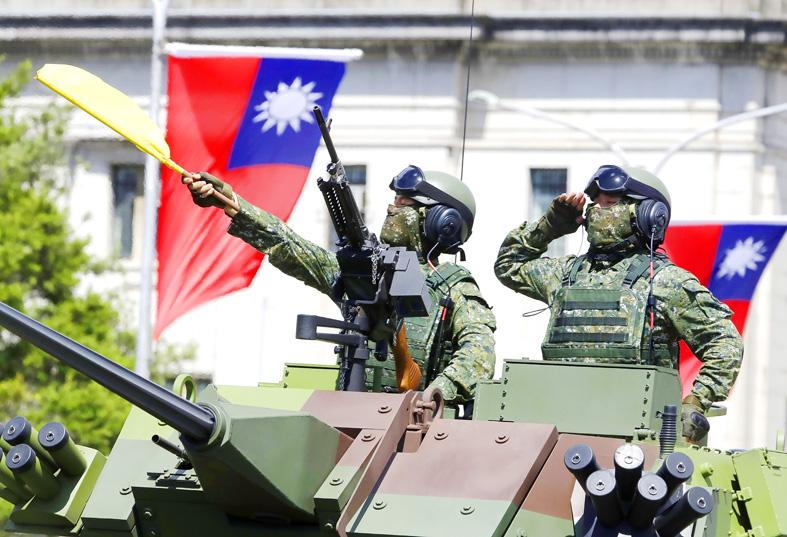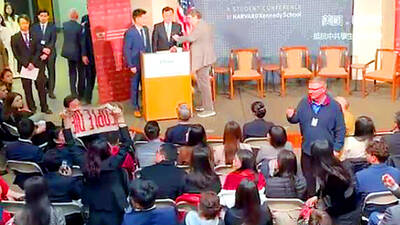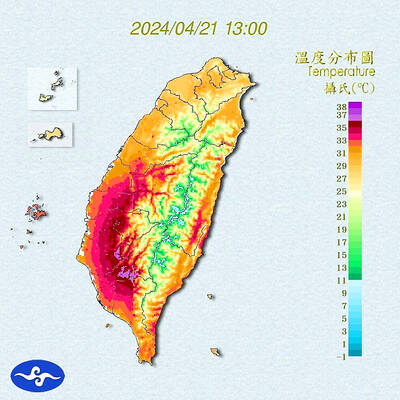Seventy-two years ago, the Chinese Communist Party (CCP) seized control of China after a bloody struggle. The defeated Chinese Nationalist Party (KMT) government fled to Taiwan.
Since then, China has arisen as a superpower rivaling the US, while Taiwan has blossomed into a self-governing democracy and high-tech powerhouse with Washington’s backing.
Now, after decades of stalemate, there is a renewed risk of conflict.

Photo:Chiang Ying-ying, AP
While it is impossible to know how this long rivalry will play out, in some respects the battle for Taiwan is already under way.
As Reuters reported in December last year, the Chinese People’s Liberation Army (PLA) is waging so-called “gray zone” warfare against Taiwan. This consists of an almost daily campaign of military exercises, patrols and surveillance.
Since that report, the campaign has intensified, with Beijing stepping up the number of warplanes it is sending into the airspace near Taiwan. China has also used sand dredgers to swarm Taiwan’s outlying islands.
Military strategists tell Reuters that the gray-zone strategy has the potential to grind down Taiwan’s resistance — but also that it might fall short, or even backfire by strengthening the nation’s resolve.
They are also envisioning starker futures.
While they cannot predict the future, military planners in Taiwan, China, Australia, Japan and the US are nonetheless gaming out scenarios for how Beijing might try to seize Taiwan, and how Taipei and Washington, along with US allies, might move to stop it.
China has a range of tactics it might adopt, military experts say.
They all carry risk for Chinese President Xi Jinping (習近平) and the CCP.
They also pose different challenges for Taiwan, and for the US and its allies, principally Japan.
Xi’s options include seizing Taiwan’s outlying islands, blockades or all-out invasion.
Some Taiwanese military experts say that Beijing’s next step might be to seize the lightly defended and remote Pratas Islands (Dongsha Islands, 東沙島).
Any of these moves could spin out of control into war, potentially drawing in the US.
This report examines some of the conflict scenarios. It is based on interviews with close to a dozen military strategists and 15 current and former military officers from Taiwan, Australia, Japan and the US.
Some serving officers spoke on condition of anonymity.
The report also draws on articles in Taiwanese, US and Chinese military and professional journals and official publications.
These scenarios are, by their very nature, speculative. There is no certainty that real conflict would follow any of these trajectories. And hostilities might not erupt at all.
However, with tensions high, accident or miscalculation could become a catalyst for clashes at any time.
SCENARIOS
In scenario 1, China could impose a blockade on Taiwan’s Matsu Islands in a bid to increase pressure on Taipei to open talks on unification.
PLA Navy ships and submarines might encircle the islands and islets. Hundreds of sand dredgers, fishing boats and Chinese paramilitary ships could also move in to bolster the surrounding flotilla.
PLA fighters then could begin round-the-clock patrols over the Taiwan Strait and warn that any Taiwanese fighters, surveillance aircraft or warships crossing the median line of the Taiwan Strait would be attacked.
Beijing would also announce that no commercial or military flights to the islands from Taiwan would be permitted without the approval of Chinese air traffic control authorities.
In scenario 2, Beijing could seize the Taiwanese island of Kinmen, which is about 6km from Xiamen on the coast of China’s Fujian Province.
The PLA could unleash an artillery and missile barrage against Kinmen’s Taiwanese army headquarters, barracks, defensive positions and key infrastructure targets.
While the bombardment continues, the PLA could land craft packed with troops on Kinmen’s beaches, with hundreds of helicopters ferrying airborne troops to seize key strategic positions.
From naval bases on the Chinese coast, dozens of Chinese warships and submarines could sail into waters between Kinmen and Taiwan proper in a bid to block any reinforcements reaching the besieged island.
In scenario 3, China could impose a snap customs quarantine of Taiwan in a bid to force the nation’s leadership to agree to talks.
Beijing would remind Taiwan’s trading partners that they all acknowledge the CCP’s claim to sovereignty over the nation, and would inform the international community that it would enforce customs, maritime and airspace jurisdiction over Taiwan.
China would also announce the creation of an air defense identification zone overriding Taiwan’s control of its airspace.
Beijing would ban all shipping from entering what had been considered Taiwan’s territorial waters without its permission, and inform all airlines and shipping companies that they must have Beijing’s official approval to enter or leave Taiwan’s airspace or ports.
In scenario 4, China could impose a full blockade in a bid to increase domestic pressure on Taipei.
Beijing would bar all shipping from entering waters around Taiwan apart from PLA Navy and Chinese paramilitary vessels enforcing the blockade.
Oil tankers heading to Taiwan from the Middle East would be diverted to Chinese terminals, and passenger and cargo aircraft would be warned that they would be attacked if they intrude into the new zone that China has imposed over Taiwan.
PLA warships and strike aircraft would be deployed in strength to block US and Japanese forces from approaching Taiwan.
With the nation isolated and shortages mounting, Beijing would demand that Taipei open unification talks.
In scenario 5, China could decide that there is no realistic prospect of gaining control of Taiwan without conflict, and launch a devastating air and missile attack.
The aim would be to smash Taiwan’s military, demoralize the population and force Taipei to the negotiating table before the US and its allies can intervene.
The PLA would launch saturation attacks on key military and civilian targets, including airfields, ports, air-defense radars, communication nodes, military command centers and key bridges, communications networks, power stations and grids, government buildings, radio and television stations, and major transport arteries.
Beijing would deploys missile, naval and air forces to keep the US and its allies from sending forces to assist Taiwan.
In scenario 6, Xi and his top commanders could be convinced that they are running out of time and that it has a narrow window to unify Taiwan by force.
They would mount the biggest and most complex amphibious and airborne landing ever attempted, with the goal to overwhelm the nation before the US and its allies can respond.
The PLA would launch massive air, missile and cyberattacks on key military and civilian targets across Taiwan.
At the same time, the PLA would attack US bases in Japan and Guam with air and missile strikes in a bid to paralyze US forces and delay any intervention.
Invasion forces would land along the Taiwan coast and fight their way inland, with airborne landings including special forces units tasked with capturing or killing the political and military leadership.
OUTCOMES
Chinese control of Taiwan would dramatically reinforce the CCP’s prestige at home and eliminate the nation as a viable model of a democratic alternative to authoritarian rule.
It would also give China a foothold in the so-called first island chain, a line running through the string of islands from the Japanese archipelago to Taiwan, the Philippines and Borneo, which enclose China’s coastal seas.
For Beijing, success would translate into a commanding strategic position in Asia, undermining the security of Japan and South Korea, and allowing China to project power into the western Pacific.
However, Beijing also has an incentive to be cautious. If the US and its allies intervened against a takeover attempt, they could inflict heavy losses on an untested Chinese military that has not fired a shot in anger for decades.
Defeat could weaken the CCP’s hold on power.
For the US alliance, a Chinese takeover of Taiwan would be a devastating blow. At a stroke, the US would lose its status as the pre-eminent power in Asia, according to most US and regional military experts.
If Washington were unwilling or unable to defend Taiwan, its network of allies in the Asia-Pacific — including Tokyo, Seoul and Canberra — would overnight be far more vulnerable to military and economic coercion from China.
Some might switch allegiance to Beijing, analysts say.
Some might seek nuclear weapons to boost their own security.
If the US did opt to defend Taiwan, though, there is no guarantee that it would defeat an increasingly powerful PLA, current and former senior US commanders said.
To counter China’s military rise, the US is now rolling out new weapons and strategy in the Asia-Pacific.
A Chinese Ministry of Foreign Affairs spokesperson said that the ministry would not comment on “hypothetical reports.”
US Lieutenant Colonel Martin Meiners, a spokesperson for the Pentagon, had no comment on “specific operations, engagements, or training” described in this report.
However, Meiners said that China had “stepped up efforts to intimidate and pressure Taiwan and other allies,” and this increases “the risk of miscalculation.”
In Taipei, the Ministry of National Defense said in a statement that the nation’s military had “drawn up relevant countermeasures and made various combat plans” regarding possible actions and attempts to invade Taiwan by the “communist army.”

A group of Taiwanese-American and Tibetan-American students at Harvard University on Saturday disrupted Chinese Ambassador to the US Xie Feng’s (謝鋒) speech at the school, accusing him of being responsible for numerous human rights violations. Four students — two Taiwanese Americans and two from Tibet — held up banners inside a conference hall where Xie was delivering a speech at the opening ceremony of the Harvard Kennedy School China Conference 2024. In a video clip provided by the Coalition of Students Resisting the CCP (Chinese Communist Party), Taiwanese-American Cosette Wu (吳亭樺) and Tibetan-American Tsering Yangchen are seen holding banners that together read:

UNAWARE: Many people sit for long hours every day and eat unhealthy foods, putting them at greater risk of developing one of the ‘three highs,’ an expert said More than 30 percent of adults aged 40 or older who underwent a government-funded health exam were unaware they had at least one of the “three highs” — high blood pressure, high blood lipids or high blood sugar, the Health Promotion Administration (HPA) said yesterday. Among adults aged 40 or older who said they did not have any of the “three highs” before taking the health exam, more than 30 percent were found to have at least one of them, Adult Preventive Health Examination Service data from 2022 showed. People with long-term medical conditions such as hypertension or diabetes usually do not

POLICE INVESTIGATING: A man said he quit his job as a nurse at Taipei Tzu Chi Hospital as he had been ‘disgusted’ by the behavior of his colleagues A man yesterday morning wrote online that he had witnessed nurses taking photographs and touching anesthetized patients inappropriately in Taipei Tzu Chi Hospital’s operating theaters. The man surnamed Huang (黃) wrote on the Professional Technology Temple bulletin board that during his six-month stint as a nurse at the hospital, he had seen nurses taking pictures of patients, including of their private parts, after they were anesthetized. Some nurses had also touched patients inappropriately and children were among those photographed, he said. Huang said this “disgusted” him “so much” that “he felt the need to reveal these unethical acts in the operating theater

Heat advisories were in effect for nine administrative regions yesterday afternoon as warm southwesterly winds pushed temperatures above 38°C in parts of southern Taiwan, the Central Weather Administration (CWA) said. As of 3:30pm yesterday, Tainan’s Yujing District (玉井) had recorded the day’s highest temperature of 39.7°C, though the measurement will not be included in Taiwan’s official heat records since Yujing is an automatic rather than manually operated weather station, the CWA said. Highs recorded in other areas were 38.7°C in Kaohsiung’s Neimen District (內門), 38.2°C in Chiayi City and 38.1°C in Pingtung’s Sandimen Township (三地門), CWA data showed. The spell of scorching